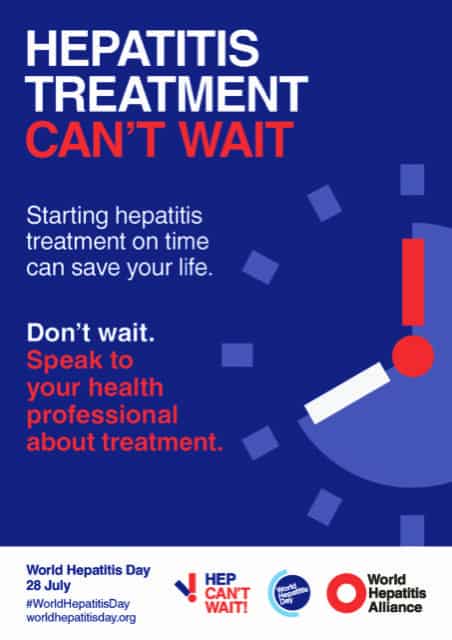
World Hepatitis Day takes place today, with this year’s theme, ‘I can’t wait’, highlighting the need to accelerate the fight against viral hepatitis to reach the 2030 elimination target.
The campaign, which is one of the World Health Organization’s (WHO) seven officially-mandated global public health days, also aims to ‘highlight the social injustice and inequity caused by the current lack of action on hepatitis elimination’, the World Hepatitis Alliance (WHA) stated.
This year, those who want to get involved can join a virtual global relay by submitting a 30 second video explaining what the elimination of viral hepatitis means to them. Participants are also encouraged to upload a photo of themselves pointing to the time under the hashtags #WorldHepatitisDay and #NOhep.
Hepatitis is an inflammation of the liver, most commonly caused by a viral infection and, according to WHA, someone dies from a viral hepatitis-related illness every 30 seconds. The five main hepatitis viruses, types A, B, C, D and E, are of greatest concern due to the burden of illness and death they cause, as well as the potential for outbreaks and epidemic spread.
According to WHO, the world is currently facing a new outbreak of unexplained acute hepatitis infections affecting children, directing the focus on the thousands of acute viral hepatitis infections that occur among children, adolescents and adults every year.
Most acute hepatitis infections cause mild disease and even go undetected, but in some cases, they can lead to fatal complications. In 2019 alone, an estimated 78,000 deaths occurred worldwide due to complications of acute hepatitis A to E infections, WHO said.
The elimination of hepatitis infections B, C and D is prioritised as, unlike acute viral hepatitis, these three infections cause chronic hepatitis that lasts for several decades and are responsible for over one million deaths per year from cirrhosis and liver cancer, and are responsible for over 95% of hepatitis deaths.
On World Hepatitis Day 2022, WHO has outlined its aims to achieve hepatitis elimination by 2030, calling on countries to achieve specific targets. This includes reducing new infections of hepatitis B and C by 90%, and reducing hepatitis-related deaths from liver cirrhosis and cancer by 65%.
Moreover, WHO’s set targets also include ensuring that at least 90% of people with hepatitis B and C virus are diagnosed, and that at least 80% of those eligible receive appropriate treatment.
Danjuma Adda, president, WHA, said: “The gains made to eliminate hepatitis have been uneven across the world, with those most impacted often the least likely to benefit. Most countries have failed to meet their Global Health Sector Strategy 2020 targets and many babies still lack access to the hepatitis B birth dose vaccine in many low- and middle-income countries, with less than 10% in Africa receiving a timely vaccine.
“Governments and global funders are turning a blind eye to the 1.1 million deaths each year and the continued impacts on communities across the world. We will no longer accept their excuses. It takes courage to speak out, but this World Hepatitis Day we come together globally to say ‘I can’t wait’ for an end to hepatitis and urge policy makers, global funders, and decision makers to act by increasing investment and financing hepatitis elimination.”




